
Woods Keeper at
Chastain Park

Chastain Park Summer Update 9.1.24
Hot and dry oh my! Summer conditions can be tough to work in but being surrounded by the beautiful wildlife in Chastain Park sure makes things easier. We’ve been working hard down by the champion Green Ash removing and suppressing invasive stiltgrass, porcelain berry, beefsteak, hairy crabweed and more. We’re thrilled to watch natives such as Spotted St. John’s Wort, Woodland Sunflower, Panic grass, Asters, and Goldenrod, and more thrive and spread into areas that not so long ago were dominated by English ivy and other invasive plants.
Recently we spent time in the “Palisades” area on Nancy Creek to keep the kudzu at bay and were pleasantly surprised by natives Florida Pusley (Richardia scabra) and Sensitive Pea (Chamaecrista nicititans) emerging on the banks where there was a blanket of kudzu last year.
It’s always a pleasure to work in Chastain Park and we hope if you see us around you’ll stop and say hi!
— Woods Keeper
Native Florida Puseley
Richardia scabra
Native Spotted St. John’s Wort
Hypericum punctatum
Invasive
Hairy Crabweed
Fatoua villosa
Invasive
Beefsteak
Perilla frutescens
Overview:
In Spring of 2022 Woods Keeper began work at Chastain Park in an area once nicknamed “kudzu canyon” that’s no stranger to restoration work. Many native plants like trillium, buckeye, sunflower, goldenrods, and asters are naturally returning in some areas while remaining invasive plants like English ivy still dominate in others (before-&-after shown below). Other targeted non-native invasive plants include privet, porcelain berry, elaeagnus, stiltgrass, and multiflora rose.
Working alongside Chastain Park Conservancy who is actively planting native plants throughout the park, Woods Keeper is continuing restoration efforts to remove and suppress these harmful invasive plants while nurturing the native plants and trees that support our local ecosystem. A small offshoot of Nancy Creek runs through the area supporting healthy populations of jewelweed, American jumpseed and much more. The stream flows over the roots of an enormous green ash tree (shown below), a tree so big it made the Atlanta Champion Tree list at #2 for this endangered species.
As the transformation unfolds from an unhealthy and overwhelmed landscape to a biodiverse and abundant woodlands, beauty will naturally follow. Check back for updates, or better yet come see for yourself!
**Does native habitat restoration mean every plant that’s non-native will be removed? No. We believe non-native plants can have a place in landscapes as long as they are not invasive. This issue is not black and white and often requires a nuanced discussion involving the specifics of the site.
Not only does invasive plant removal improve the health and beauty of our natural areas, it also makes trails more inviting.
Brian Barnes of Chastain Park Conservancy and Eli Dickerson of Park Pride measure the large green ash (Fraxinus pennsylvanica).
A host to swallowtail caterpillars and many moths, green ash trees also provide cover and food to many bird and animal species. The green ash has rapidly become endangered in North America due to the Emerald Ash Borer, an invasive beetle whose larvae feed on the inner bark ultimately killing the tree.
Still seemingly healthy for now, this green ash at Chastain Park measures over 11 feet in circumference, 100 feet high, and 60 feet in average crown spread putting it at #2 on Trees Atlanta’s Champion Tree list.


















